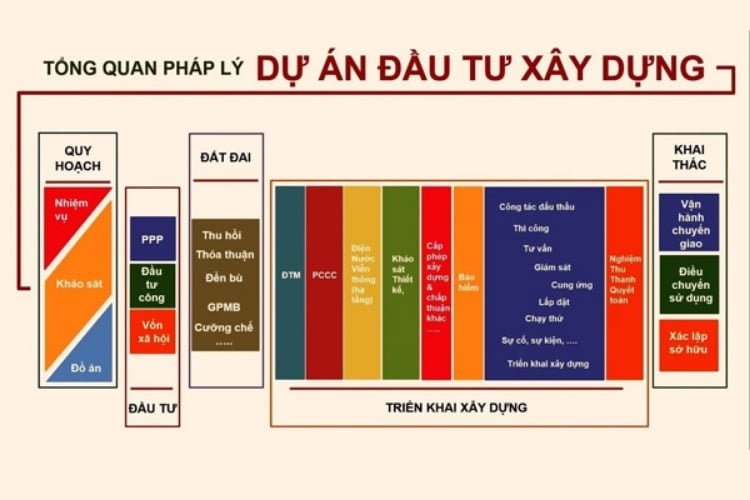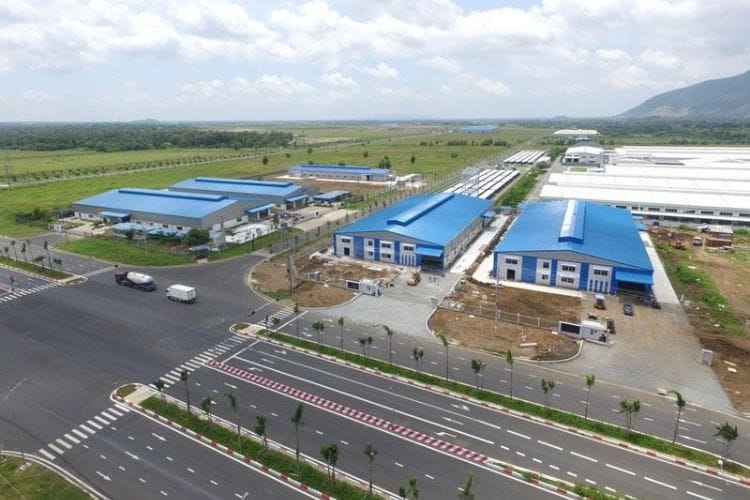When implementing a construction investment project, it is necessary to follow a truly guaranteed and scientific process to achieve the highest efficiency. The following article will contain content about the process and steps of implementing a construction investment project in a concise and easy-to-understand manner so that readers can grasp the most condensed content.
1. Things to know about construction investment projects
1.1. What is a construction investment project?
Investment is the activity of using financial resources, material resources, labor and intellectual resources for production and business over a relatively long period of time to gain profits and socio-economic benefits.
According to the provisions of Clause 15, Article 3 of the Construction Law 2014, construction investment projects are defined as follows:
Article 3. Explanation of terms
…
15. Construction investment project is a collection of proposals related to the use of capital to conduct construction activities to build new, repair and renovate construction works to develop, maintain, Improve the quality of projects or products and services within a specified time and cost. At the stage of preparing a construction investment project, the project is expressed through a Construction Investment Pre-feasibility Study Report, Construction Investment Feasibility Study Report or Investment Economic-Technical Report. construction investment.
Construction activities will include work as prescribed in Clause 21, Article 3 of the 2014 Construction Law, including:
- Prepare construction planning;
- Establishing construction investment projects;
- Construction survey;
- Design and construction;
- Construction;
- Construction supervision;
- Project management;
- Contractor selection;
- Acceptance, handover and putting the project into operation, warranty and maintenance of construction works;
- Other activities related to construction.
1.2. Characteristics of construction investment projects
1.2.1. About capital
When investing in construction projects, you must first have capital. Capital can be in money, in other types of assets such as machinery and equipment, factories, other construction works, the value of industrial property rights, technical know-how, technological processes, technical services, etc. value of land use rights, water surface, sea surface, and other resources. Capital can also be State capital, private capital, contributed capital, share capital, long-term, medium-term, and short-term loans.
1.2.2. Investment time
The investment period is usually relatively long, usually 2 years or more, possibly up to 50 years. Short-term activities within a financial year are not called investments.

2. Process of steps in implementing construction investment projects
The construction investment implementation process is specified in Article 4 of Decree 15/2020/ND-CP on construction investment project management issued by the Government on March 3, 2021. The process can be divided into three implementation phases: Project preparation phase, project implementation phase and specific construction completion phase, as follows:
2.1. Construction investment preparation stage
Step 1: Construction planning
Any construction investment project that wants to be formed needs to re-check the planning of the proposed project area. The state manages projects according to planning, so projects that want to be formed must have detailed planning (QHCT). The responsibility for formulating, appraising and approving strategic plans lies with the local government.
The construction planning process includes the following steps:
- Apply for planning permission.
- Planning 1/2000.
- Architectural planning agreement.
- Planning 1/500.
- Approval of detailed planning 1/500 and preliminary architectural plans.
When implementing planning, it is necessary to have a review step to ensure 2 purposes:
- The first purpose : The project is located in an area that does not have detailed planning, so investors need to wait for the locality to prepare detailed planning. However, investors usually propose to sponsor the preparation of strategic planning.
- Second purpose : The project is located in an area that already has detailed planning. Investors, depending on their purposes, need to apply for adjustments to the master plan to meet the purpose and investment efficiency.
Note: The investor may not become the Project Investor later.
Step 2: Select Investor
After the detailed planning has been approved according to the correct process, the locality needs to select investors. There are 3 forms of Investor selection, as follows:
- Form 1: Bidding for Investor selection.
- Form 2: Auction of land use rights only applies to clean land (cleared land).
- Form 3: Decision on investment policy/issue of Investment Registration Certificate. This is a form of investor designation, currently limited in application in localities.
Step 3: Approve the Feasibility Study Report and Basic Design Documents
The investor prepares, submits for appraisal and approves the feasibility study report and basic design documents to have a basis for implementing the next steps in preparing and submitting for appraisal in compliance with the provisions of the Construction Law. build.
Step 4: Report on environmental impact assessment when implementing the project
Approve the environmental impact assessment report or confirm the commitment to the environmental protection plan (for land auction projects, investor selection bidding projects and projects that have implemented policy decision procedures investment, issuance of Investment Registration Certificate before carrying out environmental procedures).
Step 5: Complete land procedures
Land allocation, land lease, land recovery; issue certificates of land use rights, ownership of houses and assets attached to land.
2.2. Phase of investment in construction works
The project implementation phase includes the following tasks: preparing construction sites, clearing bombs and mines (if any); Construction survey; prepare, appraise and approve designs and construction estimates; granting construction permits (for projects that according to regulations must have a construction permit); selecting contractors and signing construction contracts; Construction works; construction supervision; advance payment, payment for completed volume; operation and test run; Acceptance of completed construction works; Handing over the project to use and other necessary work;
After completing land procedures and having a land allocation decision or land lease contract (no need for a certificate of land use rights, ownership of houses and assets attached to land) is enough. conditions for implementing investment steps.
Phase II will include the following steps:
Step 6: Prepare, evaluate and approve Construction Drawings
The investor prepares construction drawings and appraises them according to regulations, depending on the scale of the project. Approved construction drawings are the basis for construction implementation at the site.
The construction survey process can be divided into two stages: preliminary survey to serve investment reports and detailed survey to serve design.
The process of this step will be followed in the following order:
- Prepare and approve construction survey tasks (KSXD).
- Select construction contractor.
- Prepare and approve construction inspection technical plans.
- Carry out construction surveys.
- Supervise construction survey work.
- Additional survey (if any).
- Acceptance of construction survey results.
- Store construction survey results.
Construction design includes the following steps: preliminary design (in case of preparing a pre-feasibility study report), basic design (done during the construction investment project planning stage), technical design. art; design construction drawings and other design steps (if any). The investment decision maker decides to carry out the design according to the following steps:
- One-step design: three design steps are combined into one step called construction drawing design (the project only prepares economic and technical reports).
- Two-step design: basic design step and construction drawing design step (project must be prepared for the project).
- Three-step design: Includes basic design step, technical design step and construction drawing design step (for large-scale, complex projects).
Sequence of implementing construction design:
- Set up project design and construction tasks.
- Recruitment and selection of architectural designs for construction projects (if any).
- Selecting a contractor to design and construct the project.
- Project construction design.
- Basic design appraisal (done at the same time as investment project appraisal); Appraisal of economic and technical reports.
- Appraisal of technical design (3-step design) and construction estimate; design construction drawings (2-step design) and construction estimates; Carry out design verification to serve appraisal work.
- Approve technical design (3-step design) and construction estimate; design construction drawings (2-step design) and construction estimates.
- Expertise; Approve technical design (3-step design) and construction estimate; design construction drawings (2-step design) and construction estimates.
- Design changes (if any).
- Acceptance of construction design.
- Supervise the author.
Step 7: Prepare and approve documents requesting approval for fire prevention and fighting (fire prevention)
Step 8: Apply for construction permit
Step 9: Deploy construction on site
First, the investor needs to select a contractor to construct the project. Then, a construction supervision contractor will be selected.
Next, the investor prepares and verifies the request for expression documents, prequalification documents, bidding documents, request documents and evaluates the expression of interest documents, prequalification documents, bidding documents, and application documents. proposal documents for contractor selection in construction activities; Verify the results of contractor selection in construction activities. Finally, the investor will announce the start of construction.
Implementation of construction on site must ensure the following factors:
- Implement management of quality, volume, progress, construction costs, construction contracts, labor safety on construction sites, construction environment…
- Implement and manage project information system.
- Construction specialized testing (on request).
- Acceptance of work, stages and completed projects.
- Advance payment, payment for completed volume.
- Inspect the quality of construction works by state management agencies upon acceptance and completion before putting the project into use.
- Check and confirm the implementation of environmental protection works and measures to serve the project operation phase.
Step 10: Complete construction and put the project into use.
In step 10, you need to perform the following tasks in the following order:
- Handing over the completed project for use; operate and test run.
- Payment and finalization of project construction investment capital.
- Audit, verify, and approve the final settlement of construction investment capital.
- Supervise and evaluate construction investment projects (in case of hiring consultants
- Grant of operating license:
- Open industry, profession…;
- Permission to operate;
- Certificate of eligibility (Project in conditional investment field). Certificate of project ownership/house ownership.
- Insurance, warranty, maintenance of construction works.
- International quality registration (if any).





